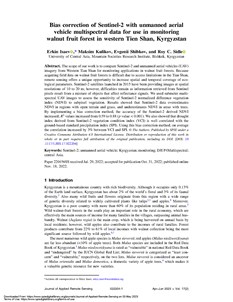Bias Correction of Sentinel-2 with Unmanned Aerial Vehicle Multispectral Data for Use in Monitoring Walnut Fruit Forest in Western Tien Shan, Kyrgyzstan
Published: Journal of Applied Remote Sensing, Vol. 17, Issue 2, 022204 (November 2022)
https://doi.org/10.1117/1.JRS.17.022204
Abstract
The scope of our work is to compare Sentinel-2 and unmanned aerial vehicles (UAV) imagery from Western Tian Shan for monitoring applications in walnut fruit forests. Because acquiring field data on walnut fruit forests is difficult due to access limitations in the Tian Shan, remote sensing offers a unique opportunity to increase spatial and temporal coverage of ecological parameters. Sentinel-2 satellites launched in 2015 have been providing images at spatial resolutions of 10 to 20 m; however, difficulties remain as information retrieved from Sentinel pixels result from a mixture of objects that affect reflectance signals. We used submeter multispectral UAV images to assess the sensitivity of Sentinel-2 normalized difference vegetation index (NDVI) to subpixel vegetation. Results showed that Sentinel-2 data overestimates NDVI in regions with open terrain and grass, and underestimates NDVI in areas with trees. By implementing a bias correction method, the accuracy of the Sentinel-2 derived NDVI increased; R2 values increased from 0.59 to 0.88 (p value < 0.001). We also showed that drought index derived from Sentinel-2 vegetation condition index (VCI) is well correlated with the ground-based standard precipitation index (SPI). Using this bias correction method, on average the correlation increased by 3% between VCI and SPI.



